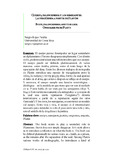Mostrar el registro sencillo del ítem
Cuerpo, palingenesia y los semejantes. La vergüenza a partir de platón
| dc.creator | Rojas Peralta, Sergio E. | |
| dc.date.accessioned | 2022-05-06T20:41:40Z | |
| dc.date.available | 2022-05-06T20:41:40Z | |
| dc.date.issued | 2022 | |
| dc.identifier.citation | https://revistas.upr.edu/index.php/dialogos/article/view/19512 | es_ES |
| dc.identifier.issn | 2693-9339 | |
| dc.identifier.uri | https://hdl.handle.net/10669/86554 | |
| dc.description.abstract | El cuerpo parece desempeñar un lugar secundario en el platonismo. Pero no desaparece simplemente. Con el mito de Er, podemos introducir una reflexión sobre qué es el cuerpo. El cuerpo puede ser definido platónicamente de varias maneras: como tumba, prisión, como el resto luego de la separación del alma. Entre los diversos trabajos de mitografía de Platón introduce una especie de triangulación entre la polis, la poièsis, y ta tès psukhès eida, frente a la cual aparece el daño en el alma, que antes o después se refleja en el cuerpo. Y entonces, el cuerpo cumple una función soteriológica – ideológica – en la medida en que tiene que ver con el cuidado de sí. Platón habla de ser visto por los semejantes (Rep. X, 604a). Esto remite nuevamente a la mitografía y a la noción de la cual una cierta reputación ("vergüenza") debería interiorizarse a partir de la reputación según los otros ("empatía"). Y los otros, los semejantes, se convierten en modelo del cuerpo. Entre vida y vida, el cuerpo es el intermediario necesario para entender no sólo el paso entre una vida y otra, sino el sentido de la ἐπιμέλεια y la justicia. | es_ES |
| dc.description.abstract | The body seems to play a secondary role in Platonism. But it does not simply disappear. Er’s myth allows us to introduce a reflection on what the body is. The body can be defined platonically in various ways: as a tomb, as a prison, as the remains after the separation of the soul. Among Plato’s various works of mythography, he introduces a kind of triangulation between the πόλις, the ποίησις and τὰ τῆς ψυχῆς εἴδα, against which damage to the soul appears, which sooner or later is reflected in the body. And then, the body fulfils a soteriological – ideological – function insofar as it has to do with self-care. Plato speaks of being seen by one’s fellows (Rep. X, 604a). This again refers to mythography and the notion that a certain reputation (shame) should be internalized according to others (“empathy”). And the others, the fellows, become the model for the body. Between one life and another, the body is the necessary intermediary to understand not only the passage from one life to the next, but also the meaning of ἐπιμέλεια and justice. | es_ES |
| dc.language.iso | spa | es_ES |
| dc.source | Diálogos, año LIII(110), pp.9-32. | es_ES |
| dc.subject | Cuerpo | es_ES |
| dc.subject | Semejante | es_ES |
| dc.subject | JUSTICIA | es_ES |
| dc.subject | Vergüenza | es_ES |
| dc.subject | Empatía | es_ES |
| dc.subject | Platón | es_ES |
| dc.subject | Body | es_ES |
| dc.subject | Similar | es_ES |
| dc.subject | JUSTICE | es_ES |
| dc.subject | Shame | es_ES |
| dc.subject | EMOTION | es_ES |
| dc.subject | Plato | es_ES |
| dc.title | Cuerpo, palingenesia y los semejantes. La vergüenza a partir de platón | es_ES |
| dc.title.alternative | Body, palingenesia and the like. On shame from plato | es_ES |
| dc.type | artículo original | es_ES |
| dc.description.procedence | UCR::Vicerrectoría de Docencia::Artes y Letras::Facultad de Letras::Escuela de Filosofía | es_ES |
Ficheros en el ítem
Este ítem aparece en la(s) siguiente(s) colección(ones)
-
Filosofía [160]


